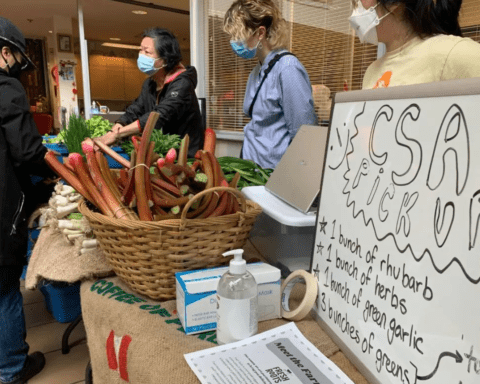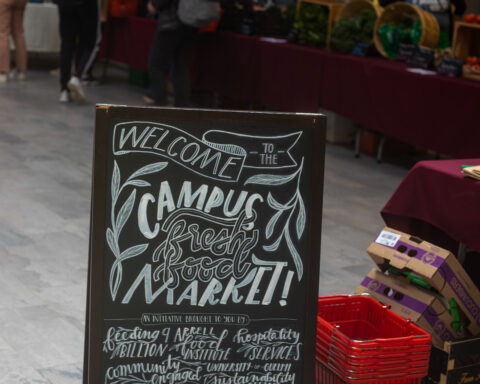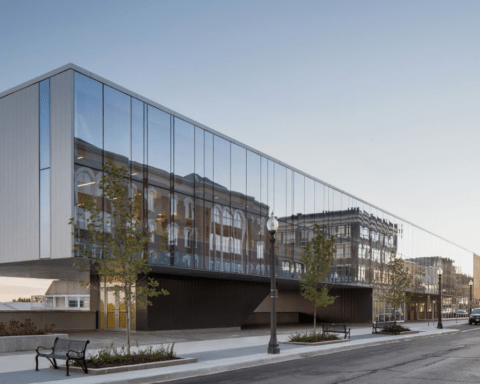The first thing you notice when you walk into the light-drenched main room at Calgary’s The Alex Community Food Centre is the promise written in loopy script above the open kitchen: “Good food is just the beginning….” Or maybe it’s the bright chairs in Crayola red and blue and green. Or the large family-style tables where everyone gathers to eat delicious homemade meals together. Wherever your eyes happen to land, it’s clear the entire centre is designed to make people in this diverse low-income community feel at home.
At a time when public discourse is deeply polarized, when scarcity rather than generosity frames so much of our collective conversation, when many of us have never felt more disconnected from one another, a beautiful and welcoming public space comes as something of a surprise. Yet there’s nothing accidental about it. The Alex and our other partner Community Food Centres and Good Food Organizations across the country, finding ways to create inclusive, thoughtfully designed spaces is a core priority.
Nobody needs to explain why to Ellen*, a participant in the Diabetes Cooking Group at NorWest Co-op Community Food Centre in northwest Winnipeg: “This place will change your spirit,” she says. “As a newcomer, sometimes you feel discriminated against. But this place lifts you up, pushes the negative thoughts away.”
Creating spaces where people can come together and feel respected, spaces that not only make room for diversity, but actively embrace it, is central to the movement we’re building. It’s an approach rooted in the belief that the physical — how a place looks, feels, flows — plays a big part in determining the social — how people feel, treat one another and work together. When low-income community members step into The Alex or NorWest, Dartmouth North or other Community Food Centres, they see fresh, bright, well-kept rooms, comfy chairs to relax on, maybe fresh flowers on the tables, art or murals on the walls, books and magazines to flip through. Signs direct people to the resources they need. The smell of good food—fresh bread, homemade soup — wafts out of the kitchens. The sounds of laughter and maybe even a bit of live music animates the rooms.
“It’s not like a soup kitchen. For a brief time, I feel like a king. And the food looks like it comes out of a magazine!” -Peter, Program Attendee
For many low-income community members who live in small apartments or shared rooms, who might work long hours for low pay, who have to spend far too much time in the demoralizing work of negotiating the social service or justice system, Community Food Centres offer not just a nice place to spend time, but a true respite. And at its best it can shift their experience away from deprivation and toward something more interactive, respectful and engaged.
“I feel comfortable as soon as I come in the door,” explains Peter*, who comes for the community lunch program at Dartmouth North CFC. “It’s not like a soup kitchen. For a brief time, I feel like a king. And the food looks like it comes out of a magazine!”
Of course, good food is central to creating these positive, friendly places. Step into The Local CFC in Stratford, ON, and you’ll find yourself in the heart of the kitchen. There’s always a group standing around the big open island mixing or chopping, baking or cooking. The pleasure of cooking and sharing a good meal allows community members to find connections that cut across barriers of language, race, class and culture.
For instance, The Alex CFC recently collaborated with the United Way to organize a potluck at the centre that brought together Aboriginal and Filipino leaders to address a history of conflict between their communities. Individuals ate together, then held a talking circle, and drummed together – activities that helped them focus on the connection between their communities, and sparked a promise to work together more in the future. At the Regent Park CFC in downtown Toronto, the Bengali women’s cooking group celebrated Independence Day by showcasing their substantial cooking chops to others in the neighbourhood. And at the newest Community Food Centre in Hamilton, one of the first programs on offer is an Intercultural Community Kitchen with food from many cultures, and staff and volunteers who speak English, Spanish, Kurdish and Arabic.
In our Annual Program Survey, 95% of people told us they feel part of a community at their CFC — at several centres, that number hit 100%. By creating dignified, safe and engaged spaces where good food fosters belonging, we are striving to challenge the dominant narrative of fragmentation and division. We’re creating the kind of connected, inclusive and diverse future we want to see.
“I want to make friends. I want to belong. I want a community,” Rebecca*, another participant from NorWest’s Diabetes Cooking group. “I found it here.”
Nick Saul is the co-founder and President/CEO of Community Food Centres Canada. This piece was republished with permission.




